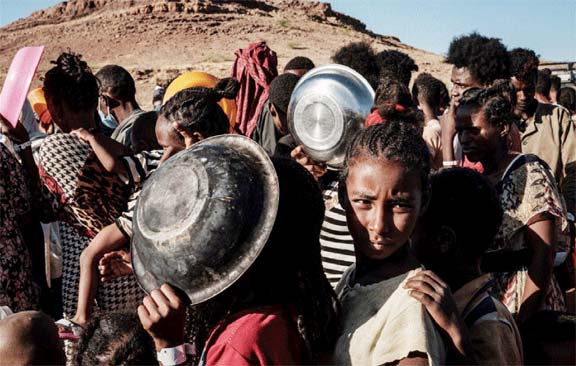
AFP :
Roughly 60% of South Sudan’s population face severe hunger by the middle of next year, the government and UN agencies warned, calling for urgent assistance to address the growing crisis.
In a new joint report, they also said that 1.4 million children face acute malnutrition in the conflict-ravaged eastern African nation. “The food security situation and nutrition situation has deteriorated,” Isaiah Chol Aruai, chairman of South Sudan’s National Bureau of Statistics, said in the capital Juba as he released the country’s latest hunger assessment.
“This is because of pockets of insecurity that have led to population displacement, low crop production because of climate shocks such as floods and drought,” he said, also pointing to the Covid-19 pandemic, an economic crisis, desert locust infestation and “inadequate” humanitarian aid.
UN-backed assessments use a ranking called the Integrated Food Security Phase Classification (IPC), which rates hunger levels from one to five.
According to the latest update, an estimated 5.8 million people face a phase-three “crisis” level of acute food insecurity between December 2020 and March 2021.
That number is predicted to rise to around 7.2 million by July, representing more than 60% of the population.
“This is the highest number since South Sudan gained independence” in 2011, World Food Programme deputy country director Makena Walker said, adding it was a five% increase compared to last year.
Friday’s update comes after two independent reports published by IPC last week said that tens of thousands of people were likely to face “famine conditions” in Pibor, in the country’s east.
Pibor was given the highest food insecurity level of five on Friday, along with the counties of Akobo, Aweil South, Tonj East, Tonj North and Tonj South.
Roughly 60% of South Sudan’s population face severe hunger by the middle of next year, the government and UN agencies warned, calling for urgent assistance to address the growing crisis.
In a new joint report, they also said that 1.4 million children face acute malnutrition in the conflict-ravaged eastern African nation. “The food security situation and nutrition situation has deteriorated,” Isaiah Chol Aruai, chairman of South Sudan’s National Bureau of Statistics, said in the capital Juba as he released the country’s latest hunger assessment.
“This is because of pockets of insecurity that have led to population displacement, low crop production because of climate shocks such as floods and drought,” he said, also pointing to the Covid-19 pandemic, an economic crisis, desert locust infestation and “inadequate” humanitarian aid.
UN-backed assessments use a ranking called the Integrated Food Security Phase Classification (IPC), which rates hunger levels from one to five.
According to the latest update, an estimated 5.8 million people face a phase-three “crisis” level of acute food insecurity between December 2020 and March 2021.
That number is predicted to rise to around 7.2 million by July, representing more than 60% of the population.
“This is the highest number since South Sudan gained independence” in 2011, World Food Programme deputy country director Makena Walker said, adding it was a five% increase compared to last year.
Friday’s update comes after two independent reports published by IPC last week said that tens of thousands of people were likely to face “famine conditions” in Pibor, in the country’s east.
Pibor was given the highest food insecurity level of five on Friday, along with the counties of Akobo, Aweil South, Tonj East, Tonj North and Tonj South.

